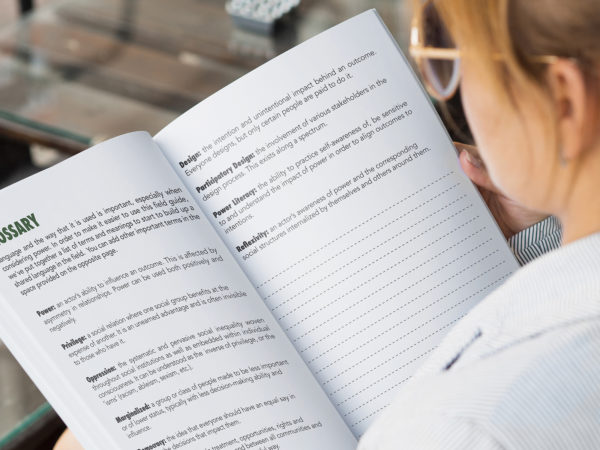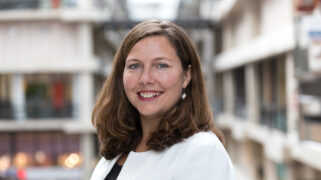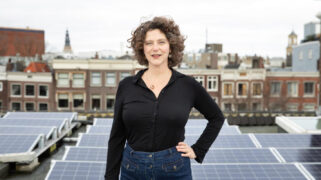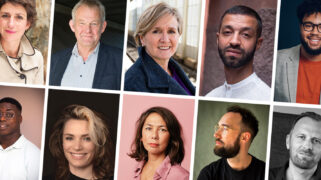What we’ve learned about power and anti-oppression
Last year, design researcher and facilitator Maya Goodwill created ‘A Social Designer’s Field Guide to Power Literacy’ in collaboration with Kennisland. The guide aims to support designers, facilitators, researchers and other practitioners working in the social and public sector to become more aware of power dynamics in our work, while motivating us to challenge existing inequities by giving up some of our own power. We have spent the last six months taking steps to further integrate the field guide and the power literacy framework in our research and design processes. In this article, we would like to share with you what we have learned so far.
- KL'ers involved
- Sarai Zwinnen
Last year, design researcher and facilitator Maya Goodwill created ‘A Social Designer’s Field Guide to Power Literacy’ in collaboration with Kennisland. The field guide is designed as an entry point to the hard work of challenging the interlocking systems of oppression (e.g. colonialism, white supremacy, heteropatriarchy, etc.) that many of us have internalised and continue to reproduce in our design practices. The guide aims to support designers, facilitators, researchers and other practitioners working in the social and public sector to become more aware of power dynamics in our work, while motivating us to challenge existing inequities by giving up some of our own power. Many of our team at Kennisland worked with Maya throughout the prototyping process of the field guide in 2020. Building on this work, we’ve spent the last six months, with support from Maya, taking steps to further integrate the field guide and the power literacy framework in our research and design processes. We would like to share with you what we have learned so far.
At Kennisland, we realise we still have a lot more work to do in order to challenge systemic oppression and ensure our impact is in alignment with our intentions. After being introduced to the field guide, we wanted to find a way to integrate and embed the power literacy framework, especially Maya’s concept of “power checks” into our projects and way of working. So, we decided to collaborate with Maya once again, this time in a coaching capacity, to continue on our social justice journey. One of the first things we did was to prototype the field guide in one of our projects, iterating on the reflexivity activities and worksheets in order to make it fit our work. The translating process alone made us reflect on the meaning of power (as some English terms++TranslationsFor example, power can be translated in the terms ‘macht’ en kracht’ in Dutch. The former is associated with having influence and has a more negative connotation and the latter with strength and has a more positive connotation. don’t have a proper Dutch translation), and the power of words and language itself.
The power literacy framework consists of five forms of power found in participatory research and design process research with a distinct, yet interrelated, definition and impact. We found that viewing power through this framework better allowed us to really grasp the different ways in which power shows up in our own projects. For example, we hold power even before the start of the project in how we frame the issue, but also during the project in the way we involve the people that are directly involved in the issue. Do we, for example“By breaking down the, to me, fairly vague concept of power into five different forms, I was able to think in a rather practical way about how power occurs in our projects.” – Sarai, interview them or do we ask them to be co-creators?

Over the last months, we applied the power literacy framework and our adaptation of the field guide in our ‘Living a whole life’ project—in which we guide social innovators in developing their idea for ageing well. Having just finished the first phase of the project, it was a natural moment for reflexivity and reflection. We used this moment on how power played a role in the first part and what we could improve for the second part of the project. Using the guide, we set up a “power check” workshop.
It was difficult and uncomfortable at times; Sarai: “I realised that so many of the decisions I make on a daily basis are fairly done on autopilot and that I, just by doing that, contribute to a system of oppression.” But, although we still have only made a small step in a long and not so simple process, it was so valuable to sit together as a team and reflect.
For example, since we had already had a couple of discussions within the project team on what could be done to shift power and challenge inequity, we thought we could somewhat predict the outcome of the workshop. Nothing was further from the truth! At the end of the workshop, as many as ten actions emerged on how to challenge oppression in the project“Even if you think you already know, it’s incredibly important to take some time to check your assumptions. Then it turns out there’s still a whole world to be won.” – Fien.
For example, we realised we could better engage and empower the target group of this project (elderly people) by not just speaking to them from time to time and letting them react to things (eg. assigning them to the role of “participant”), but by shifting some of our decision-making power to them in terms of the design of the program (as co-designers). As a result, we have assembled a sounding board of elders who are helping us make decisions on integral parts of the program.
Another realisation was that we were unconsciously excluding illiterates and those who speak Dutch as their second language by our use of language. Also, by making the application procedure fully digital, we set the bar high for people who wanted to apply but are not that digitally savvy. As a result, we ran our communication through a ‘B1 Check’++B1 checkA useful website to check whether a word can also be understood by people with lower literacy is ishetb1.nl (in Dutch)., we changed the website drastically by deleting unnecessary information and making more use of visuals and we made it possible to sign up for the program by mail.
Nevertheless, we realised that this doesn’t mean the work is done, or that we won’t make mistakes in the future; there is no quick-fix when it comes to systemic oppression. What we do understand now, however, is that you have to prioritise and make time for this work, even when it feels like a slow process. It’s about becoming more aware of the invisible norms, values, beliefs and assumptions that function to marginalise and even harm certain people, and therefore it can feel uncomfortable and challenging to confront at times. As such we learned, and are still learning, to embrace this discomfort and be open to be confronted with our own assumptions, prejudices and misconceptions“I learned how easily you overlook certain assumptions that you have, and how instructive it is to make them explicit, because those are the judgements with which you look at a situation or group of people, which also influence your behaviour.” – Willemijn.
After applying the framework to this project, we’ve developed a Kennisland specific worksheet. It’s based on the field guide, but adapted to fit our way of working. We asked every project leader to incorporate it into their project going forward, and we made time to exchange our experiences with it after a month. So far, although not easy, embedding a reflexive practice into our projects in the form of a worksheet is working well for us and is something that we plan to keep using in the future. We realise that this work will be on-going for us, and will never be perfect; the more we learn, the more we become aware that there is still so much more to learn! Even so, we are convinced that the power literacy framework and its corresponding field guide are valuable and necessary resources for anyone working in the social or public sector as a designer, innovator, researcher, policy-maker or facilitator.
If you are interested in learning more, check out power-literacy.com or reach out to Maya at goodwill.maya@gmail.com.
Download Field guide
- KL'ers involved
- Sarai Zwinnen sz@kl.nl





